► EV charging claims and battery performance tested
► Mercedes EQS and Kia EV6 exceed spec
► Porsche Taycan continues to polish its 800V halo
Range might be one of the biggest considerations when it comes to picking an electric vehicle, but it’s not everything. Charging time is also an important number to consider when buying an electric car, because it’ll reduce your time charging at home – and especially in service stations and other charging points.
With that in mind, our colleagues at Autozeitung have put a selection of electric vehicles (EVs) through their paces in a bid to understand how accurate charging times and claimed charging rates really are. And the results may be different to what you expected.
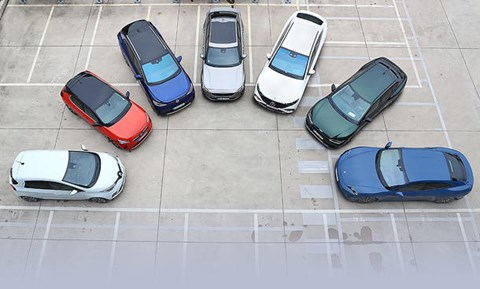
What was tested?
This isn’t a test of road performance or range, as it pitches smaller city cars against supersized electric SUVs. Instead, it’s primarily about what happens at the charge point, through the cables and in the battery.
The main takeaway is that the test vehicles charge from a 10-80% state of charge (SoC) just as the manufacturer claims. There’s also a comprehensive table, which keener dataheads can pour over here, For everyone else, we’ve broken the findings down and attributed them to the cars tested, so you can get an overall picture of the model you’re most interested in.
Electric cars: further reading
The test
To make the tests fair and the results as comparative as possible, the tests were carried out using CCS rapid connectors, in order to ensure consistency across all vehicles. That said, not all vehicles can receive the maximum power delivery – but more on that in a bit.
Since temperature also affects battery performance, the less-than-ideal test conditions were also noted; four to eight degrees Celsius from cold. With that in mind, eco mode was engaged, climate control was turned on, an a route including urban, country roads and motorway was used. Because the test took place in Germany, the EVs were also taken up to a top speed of 124mph. This meant battery capacity was down to just under 10% in all cars, and also meant the batteries were at a more optimal temperature for charging (between 20-40°C).
What we found out
- Polestar 2 Long Range Single Motor
- Mercedes EQS 580 4Matic
- Kia EV6 77 kWh AWD
- Vauxhall Corsa-e
- VW ID.4 Pro Performance
- Porsche Taycan 4S
- Renault Zoe E-Tech R135 ZE. 50
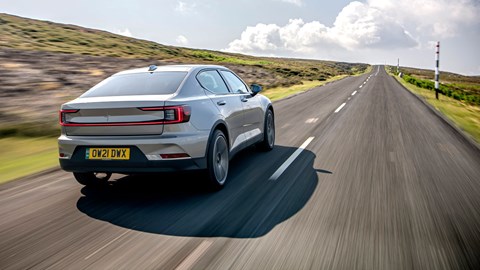
- Battery size: 75kWh
- Max engine output: 170kW
- Max charge input: 150kW
The test used a singlem-motored front-wheeled effort of Polestar 2. Significantly, Polestar has integrated the navigation with a battery pre-conditioning system: if you set the guidance to a selected charging point, the batteries will preheat the batteries to the optimum temperature for charging.
This means the Polestar 2 Long Range Single Motor can take 144kW charging after just two minutes, which increases to the claimed 150kW after four minutes. The Polestar also impressively shows what applies to almost every electric car: You should disconnect the CCS connector at the latest when the SoC is 80 %. Why? Because while the 75 kWh battery only needs 36 minutes to charge from 10 to 80%, it takes another 87 minutes to reach 100%.
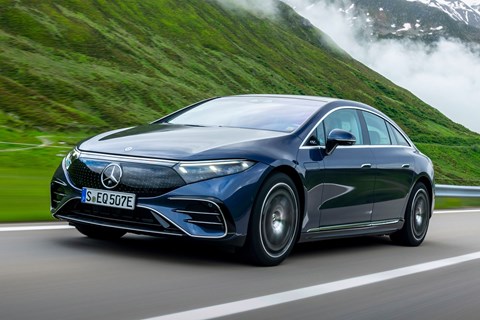
- Battery size: 107.8kWh
- Max engine output: 385kW
- Max charge input: 200kW
The Mercedes EQS 580 4Matic is pitching to take these guys on if it gets the chance. Unladen, the EQS is 2585kg (comparatively, the Renault Zoe is about 1000kg lighter). Yet, the EQS’ 107.8kWh battery delivers a breathtaking 631lb ft of torque, pushing 517bhp in old money—now referred to as engine output of 385kW.
While its heft doesn’t do the EQS any favours, this test is not about straightline speed. It’s the speed of the ions that really matter and here, the Mercedes EQS surprised by charging faster than the manufacturer specified. Only by one minute, granted. Like the Polestar 2, the battery preconditioning is hooked up to the navigation too.
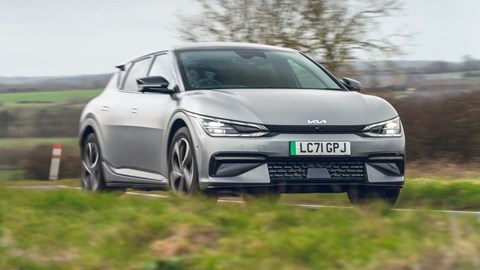
- Battery size: 77.4kWh
- Max electric output: 239kW
- Max charge input: 240kW
We were impressed with the performance and style of the Kia EV6 when we pitched it against the Hyundai Ioniq 5 – and the stats from this test were equally good. One of only two models on the market to feature the 800V inverter technology, it meant the EV6 can accept the same power with a lower current and therefore a lighter cable.
Though it doesn’t have a pre-conditioning feature, the Kia EV6 only took five minutes to condition the batteries for an optimum charging rate. Testers recorded an increase from 200kW to 230 kW after five minutes, then more after 10 minutes. The eventual max charge input was 238kW, respectfully close to Kia’s claimed 240kW.
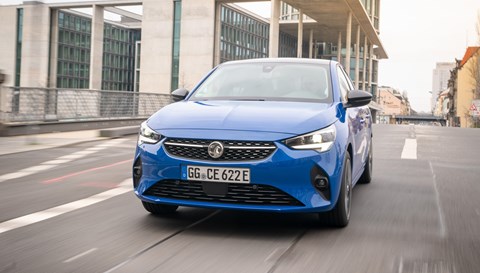
- Battery size: 46kWh
- Max electric output: 100kW
- Max charge input: 100kW
The Vauxhall Corsa-e is a stylish city car built on award-winning Stellantis EV architecture and arguably one of the more affordable all-electric models on the market. The test however highlighted a couple of concerns.
With a peak charge value of 91 kW, the Vauxhall Corsa-e misses the possible 100 kW maximum and charging power drops by 10 to 20 kW over 10 minutes. We were also surprised to note quite a significant drop in range. Over a 72.7-mile journey, the on-board computer recorded a loss of 137 miles of range. Although significant range loss is expected on motorways from all EVs, it was especially bad on the Corsa-e.
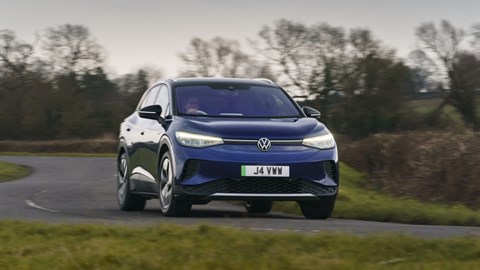
- Battery size: 77kWh
- Max electric output: 150kW
- Max charge input: 125kW
Snuggling in nicely between the T-Roc and Tiguan, the Volkswagen ID.4, is a bit of a headturner both in terms of looks and performance in this test. This rear-wheel drive motor has a 400 voltage system. Yet, like the Mercedes EQS, it exceeded the manufacturer’s claims.
According to spec, the ID.4 should charge at a maximum rate of 125 kW, but the all-electric SUV even exceeds this value significantly. In the first 10 minutes of charging, power delivery increased from 126 to 132 kW.
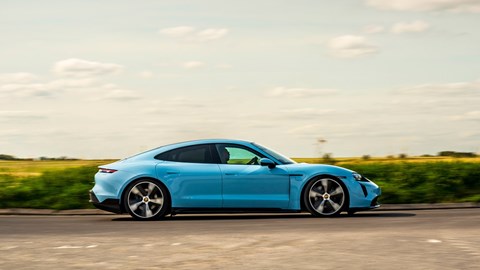
- Battery size: 83.7kWh
- Max electric output: 320kW
- Max charge input: 270kW
The Porsche Taycan is proving itself to be a true gem in the electric vehicle market. It gives every performance EV a run for its money and looks the part too. The optional 83.7kWh battery might add a fair few grand to your Taycan price tag but it’s worth it.
In the test, the Taycan 4S averaged 194kW power delivery while charging 10 to 80%. This is achieved due to the Hitachi-supplied 800V inverter and translates to 90 miles of range in just 10 minutes charging. Like the Mercedes and Polestar, Porsche has also set the navigation to pre-condition the battery before charging.
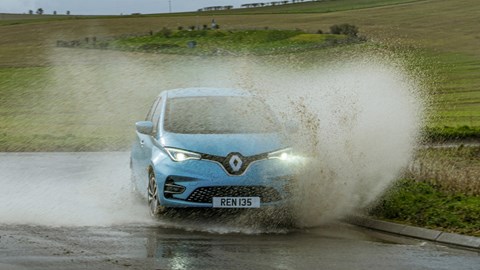
- Battery size: 52kWh
- Max engine output: 100kW
- Max charge input: 50kW
The Renault Zoe has been holding its own for some time now. Immediately after plugging in the CCS connector, the charging power jumped to 42kWh, of the claimed 50kWh. It remained at that rate for 30 minutes before another brief power increase, then it decreased continuously.
It isn’t surprising that the Zoe’s battery is capable of taking on such a charge so quickly though. It’s one of two cars on the UK market that can receive 22kW AC charge. This is important since a domestic EV charger is usually 7.4kW but households with a three-phase supply can, if they wish, opt for a 22kW charging point. However, most EVs today, including the cars on this list are limited to accept a maximum of 11kW from an AC supply (see the table for exact maximum loads).
| All data and measured values at a glance |
|
|
|
|
| Technical |
|
|
|
|
|
|
|
| Vehicle |
Kia EV6 77.4 kWh AWD |
Mercedes EQS 580 4Matic |
Opel Corsa-e |
Polestar 2 Long Range Single Motor |
Porsche Taycan 4S Performance Plus Battery |
Renault Zoe E-Tech R135 Z.E 50 |
VW ID.4 Pro Performance |
| Motor |
dual PSM |
dual PSM |
single PSM |
single PSM |
dual PSM |
|
single PSM |
| Performance/Torque |
239kW/325PS/ 605Nm |
385kW/524PS/ 855Nm |
100kW/136PS/ 260Nm |
170kW/231PS/ 330Nm |
320kW/435PS (with overboost)/ 640Nm |
100kW/135PS/ 245Nm |
150kW/204PS/ 310Nm |
| 2WD/4WD |
4WD |
4WD |
FWD (2WD) |
FWD (2WD) |
4WD (front: constant/rear: 2-way-G) |
FWD (2WD) |
RWD (2WD) |
| Battery type |
Li-ion |
Li-ion |
Li-ion |
Li-ion |
Li-ion |
Li-ion |
Li-ion |
| Battery capacity (gross/net) |
NA/77.4kWh |
NA/107.8kWh |
50/46kWh |
78/75kWh |
93.4/83.7kWh (option: 79.2/71kWh) |
56/52kWh |
82/77kWh |
| Voltage |
826V |
396V |
400V |
400V |
835V |
400V |
355V |
| Battery manufacturer |
SK Innovation |
various suppliers |
CATL |
LG |
LG |
LG |
various suppliers |
| Range via nav |
– |
standard |
– |
standard |
standard |
– |
standard |
| Preconditioning of battery |
– |
Possible |
|
Possible (with software release P1.7) |
possible |
|
in development |
| Port type/Placement on vehicle |
Type 2 & CCS, rear right |
Type 2 & CCS, rear right |
Type 2 & CCS, rear right |
Type 2 & CCS, rear right |
Type 2 & CCS, front right, Type 2, front left |
Type 2 & CCS, vehicle front (grille area) |
Type 2 & CCS, rear right |
| Regen level / 1-pedal drive |
4/ possible |
2/ possible |
1 (B-mode)/ possible with approx. 10km/h |
2/ possible |
1/ – |
1 (B-mode)/ possible |
1 (B-mode)/ possible |
| Tyre details (front/rear) |
f/r: 225/45 R 20 |
f/r: 265/40 R 21 |
f/r: 195/55 R 16 |
f/r: 245/40 R 20 |
f: 245/45 R 20 r: 285/40 R 20 |
f: 215/45 R 17 r: 205/45 R 17 |
f: 235/45 R 21 r: 255/40 R 21 |
| Kerb weight |
2025 kg |
2510 kg |
1455 kg |
1994 kg |
2140 kg |
1501 kg |
2034 kg |
| Length/Width/Height (mm) |
4695/1890/1550 |
5216/1926/1512 |
4060/1765/1433 |
4604/1985/1479 |
4963/1966/1379 |
4087/1787/1379 |
4584/1852/1640 |
| Boot capacity (litres) |
480-1260/ 20 |
610-1770/ – |
267-1042/ – |
405-1095/ 35 |
407/ 84 |
338-1225/ – |
543-1575/ – |
| 0-100 kph (factory spec, seconds) |
5.2 |
4.3 |
8.1 |
7.4 |
4 |
9.5 |
8.5 |
| Top speed (km/h) |
185 |
210 |
150 |
160 |
250 |
140 |
160 |
| |
|
|
|
|
|
|
|
| Data points (carried out between 4-8°C ave temps.) |
|
|
|
|
| Max load performance (AC/DC) as per manf. |
10.5/240kW |
11 (opt.22)/200kW |
7.4 (opt. 11)/100kW |
11/150kW |
11 (opt.22)/225 (opt. 270) kW |
22/- (opt. 50) kW |
11/125kW |
| Max load perf DC test |
238kW |
206kW |
91kW |
150kW |
265kW |
45kW |
132kW |
| Average perf ‘State of Charge’ 10-80/10-100% Test |
168/99kW |
160/107kW |
68/41kW |
97/36kW |
194/101kW |
39/23kW |
95/73kW |
| Charge time (DC) SoC 10-80% Manufacturer v. Test |
18 / 20 mins |
31 / 30 mins |
30* / 29 mins |
35 / 36 mins |
22.5** / 20 mins |
54*** / 53 mins |
38**** / 33 mins |
| Charge time (DC) SoC 10-80% Manufacturer v. Test |
NA/ 46 mins |
NA/ 60mins |
NA/ 62 mins |
80/ 122 mins |
NA/ 52 mins |
78*/ 130 mins |
NA/ 57 mins |
| Charged range after 10/30/60 mins |
109/297/332* km |
127/308/410 km |
53/285/336 km |
115/285/385 km |
145/285/327** km |
28/98/180 km |
88/220/308 km |
| Average energy accounting for lost charge: after 10/30/60 mins |
27/ 70/ 77* kWh |
30/ 81/ 108 kWh |
13/ 33/ 42 kWh |
22/ 54/ 73 kWh |
36/ 73/ 87** kWh |
8/ 22/ 40 kWh |
20/ 50/ 72 kWh |
| Average energy per minute SoC 10-80/10-100% |
2.82/1.64 kWh |
2.58/1.76 kWh |
1.18/0.69kWh |
1.61/0.65 kWh |
3.14/1.69 kWh |
0.72/0.41 kWh |
1.60/1.20 kWh |
| Consumption/100km WLTP vs. Test |
18/22.5 kWh |
18.4/25 kWh |
15.6/19.3 kWh |
17.9/ 19.8 kWh |
21/ 21.7 kWh |
17.7/ 19.2 kWh |
16.9/ 21.2 kWh |
| CO2 emitted |
82g/km |
92g/km |
71g/km |
72g/km |
79g/km |
70g/km |
78g/km |
| Managed range WLTP vs. Test |
484 / 344 km |
672 / 431 km |
337* / 238 km |
542 / 379 km |
408 / 386 km |
386 (240) / 271 km |
517 / 365 km |
| |
|
|
|
|
|
|
|
| Pricing/Options |
|
|
|
|
|
|
|
| EV list price (€) |
52,800 |
135,529 |
29,900 |
44,930 |
106,487 |
33,890 |
44,915 |
| Bigger battery |
– |
– |
– |
– |
5,522 |
– |
– |
| Higher charge performance |
– |
– |
1,190 |
– |
1,666/5,522 |
– |
in development |
| Charge cable: Household 230V / Mode 3 |
standard/standard |
€286/standard |
standard/€250 |
standard/standard |
standard/ €298 |
€480/standard |
€175/standard |
| Charge tariff (manuf) DC |
from €0.29/kWh (Ionity) |
from €0.29/kWh (Ionity)* |
provider-dependent |
from €0.29/kWh (Ionity)** |
from €0.33/kWh (Ionity)* |
provider-dependent |
from €0.33/kWh (Ionity)* |
| Heatpump |
€1,000 |
– |
standard/€250 |
€4,500* |
€845 |
standard |
€990 |
The best electric SUVs on sale today
Longest range EVs
How to buy a secondhand EV